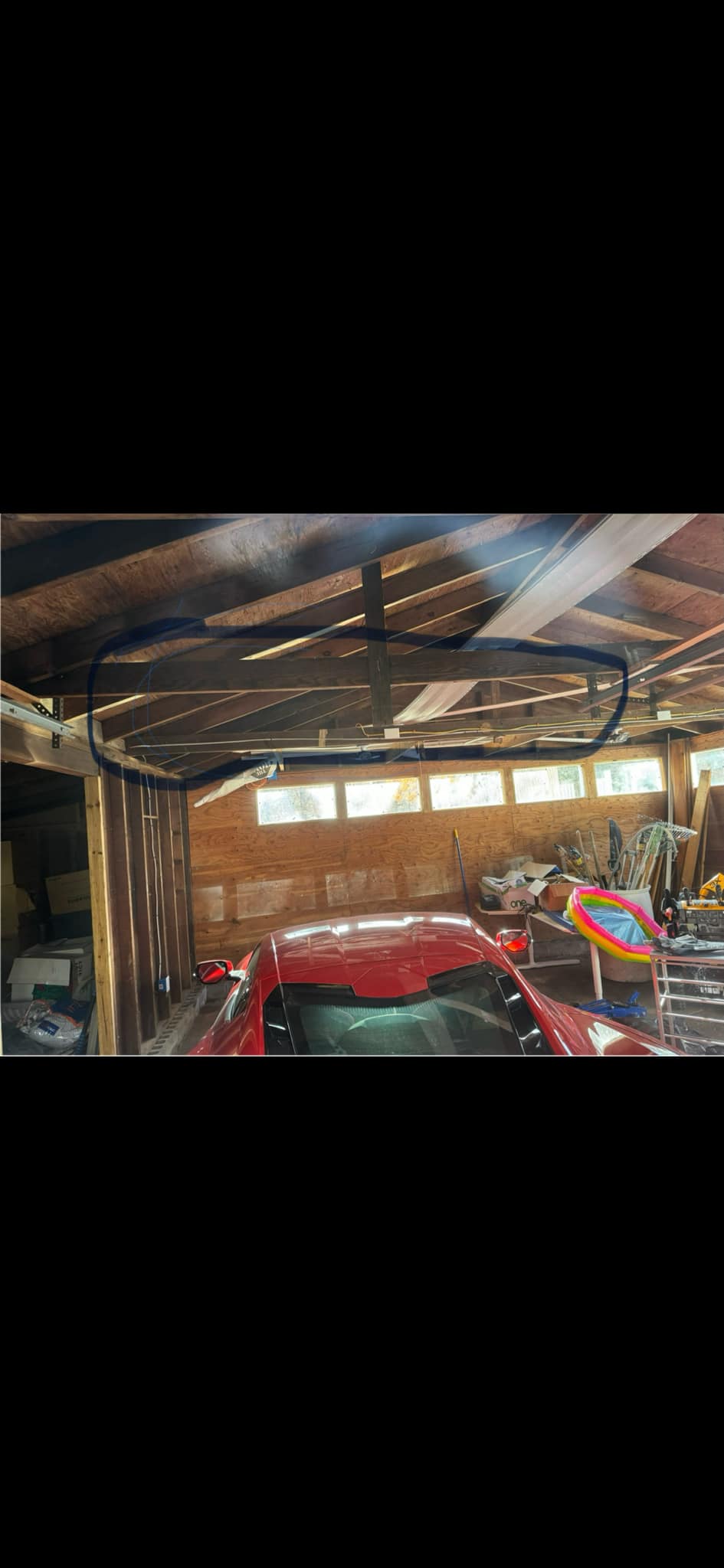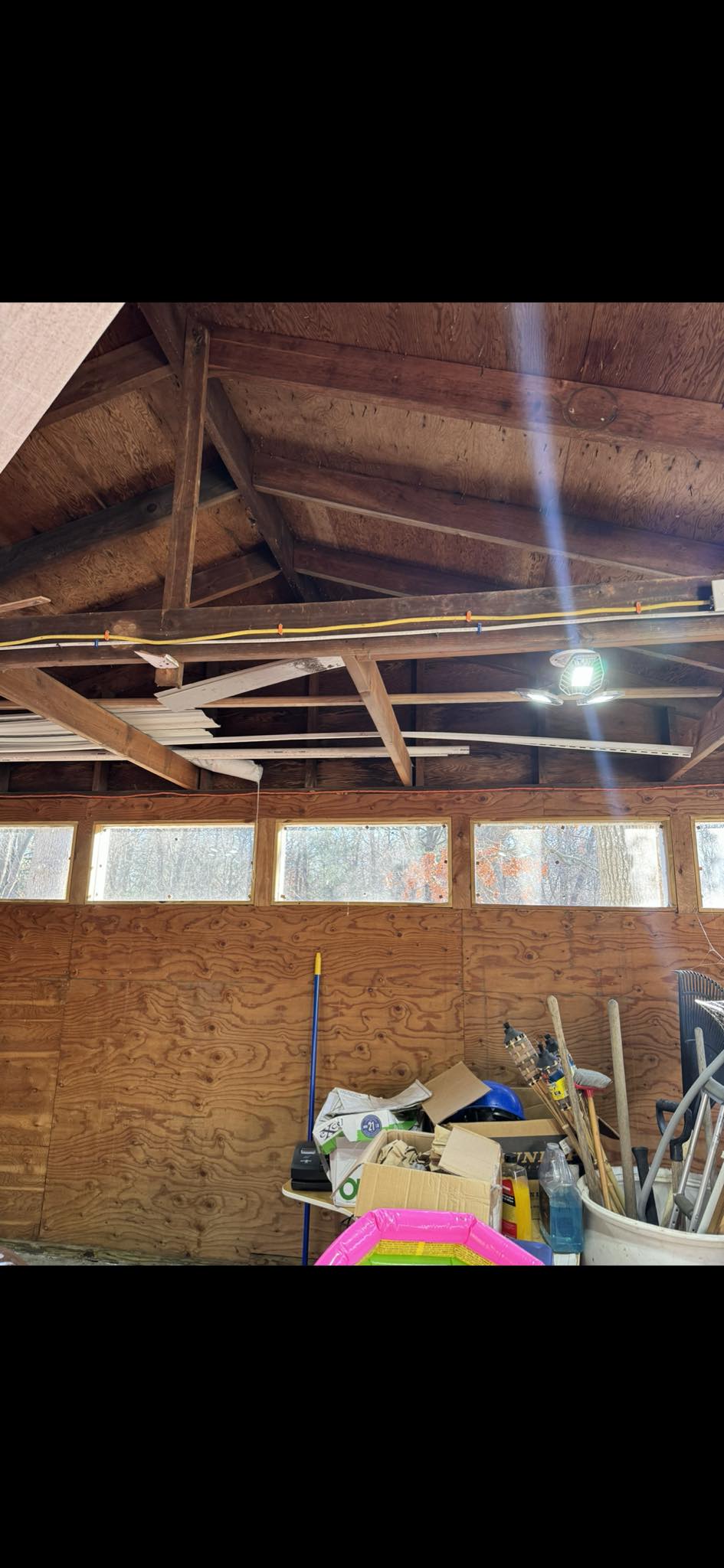Is there a safe and cost-effective way to increase ceiling height in a 2-car garage by altering ceiling joists without compromising structural integrity?
9 months ago
Last Updated: September 17, 2024
Hey everyone, I’m thinking about increasing the ceiling height in my garage by about a foot. I’m considering either raising the existing ceiling joists or adding new ones higher up and removing the lower ones. Do you have any suggestions on how to do this without compromising the structural integrity of the garage? It’s a 2 car garage that’s around 18 feet wide. Thanks for your help in advance! Here’s a close-up picture of one of the joists near the back wall.


To get a clear answer, it’s best to consult with a structural engineer.
There’s no reason why you can’t simply install new ones about a foot higher and then remove the old ones. They help prevent the walls from bowing out due to roof loads more than acting as ceiling joists. It might be a good idea to install them on each pair of rafters, instead of how they are currently placed. It wouldn’t hurt to consult with a design professional as there may be more to consider than what is visible in the pictures.
Hey, Ron! So, the general rule for rafter ties is to have them placed no more than one-third from the bottom of the rafter’s length.
The ceiling joists in the picture really aren’t doing much to support the roof. The 2×4 attached at the top of the rafter is mainly there to prevent the joists from sagging. Consider adding collar ties every or every other rafter to ensure stability. Place them at the same level and height for best results, around 1/3 of the way down from the peak to the wall height. It’s important to secure the rafter tails properly – if there are no metal ties or notches, adding ties to all rafters is recommended. Even if the rafters are notched, ties are a good idea. I have a similar roof structure over my kennels that has withstood hurricanes and strong wind storms without any issues. However, I recommend consulting with a structural expert to get a professional opinion before proceeding. It can definitely be done safely.
Is located one third of the way from the top plate of the wall to the ridge.
Hey , the 1/3 ratio is right, but the rule specifies that the new height of the rafter tie can’t exceed 1/3rd of the distance from the top plate to the ridge above the wall top plate. For instance, if the height from the top plate to the ridge is 4 feet, you shouldn’t raise the rafter tie more than 16 inches from its original position. You could technically raise it higher, but then you’d need to reinforce your rafters and the connections to the top plate to manage the increased moment.
Hey , there’s a strict rule in both the code book and engineering standards that prevents you from raising a rafter tie by more than 1/3rd of the distance from the top plate to the ridge without calculating the necessary reinforcement to handle the increased moment in the rafters.
We’re not on the same page here. How about we consider adding “collar ties” where the Author wants to raise the ceiling height by a foot? It might be a good idea to install them all the way across. Collar ties are placed in the upper third, while rafters or rafter ties go in the bottom third or on top of the wall. Adding collar ties is like affordable insurance for raising the rafters, which is the direction I’m leaning towards.
The top pitch is 11 feet. It’s 8 feet to the ceiling joist. Would it be acceptable to add rafter ties up to 1 foot higher than the current joists to every rafter?
This is the only other picture I have at the moment. I recently purchased this house but haven’t moved in yet. Just planning ahead. Any help is greatly appreciated! This picture shows one of the joists resting on the wall plate
Yes. That’s well within the one third rule. I recommend adding collar ties as an extra precaution in case of heavy snow or wind. They should be placed in the upper third of the roof space. I’d suggest every rafter on collars. Lower members or ‘rafter ties’ would need to be raised about a foot based on your comments. These provide tension support to prevent walls from being pushed outward at the top under any potential roof load. Having every other rafter should be sufficient for this situation. It seems like you want to keep the space open, I see a vehicle there, so installing a ceiling or attic storage would not be feasible without significant changes to the design. An 18′ span would require engineered lumber, steel, or a support beam through the middle (expensive). Nonetheless, I recommend consulting a General Contractor or Engineer to review and ensure that we keyboard Contractors aren’t missing anything. Hiring an Engineer in Eastern NC costs about $300 for a structural review in a home buyers Inspection. I believe it’s a worthwhile investment to ensure your plan works correctly and keeps the building secure. He might come up with better ideas that could save you time and money. He might also identify other issues that need to be addressed. By the way, I am a GC and a Home Inspector with various accreditations in Commercial and Residential construction. However, don’t just rely on my opinion as I haven’t visited the site. I could be overlooking something by just looking at a couple of pictures. Never make assumptions. Best of luck.
Thanks for breaking it down. To be honest, I just need one of those two rafter ties adjusted so I can have enough room to swing a golf club. I think I can keep the one near the back wall and just require the other one to be moved up by a foot.
I’d definitely make that trip again.
Add collar ties approximately two feet down from the peak spanning across the entire peak. Afterward, you can remove the ones that sit on top of the walls.
Providing collar ties instead of rafter ties is not advisable. Collar ties and rafter ties serve different purposes. You can’t simply swap one for the other.
Considering you have what seems to be a nice car stored there, I wouldn’t recommend solely relying on internet advice. Roof structure calculations need to be tailored to your specific conditions such as snow load, foundation, current structure, etc. Your safest and most advisable course of action would be to hire a structural engineer to create plans for you.
Let me clarify this for you. What you are calling “ceiling joists” are actually not joists. Joists span between support points to bear loads. These are essentially low “rafter ties”. They are not meant to carry load but to prevent the roof load from pushing the walls apart. Their placement can vary to some extent but is guided by specific parameters. You can go ahead with your plan to install new ones as long as they are no more than one third of the ridge height above the top of the walls. While you don’t have to put them on every set of rafters, it wouldn’t hurt to do so. It’s your property, and anything that can improve its longevity is beneficial. Any argument against the one third of the ridge height *** ABOVE THE TOP OF THE WALL *** rule is inaccurate. Best of luck with achieving the increased ceiling height you desire!
Thanks a lot, Bob! After seeing these ‘joists’ and reading the explanation, it’s clear they’re not load-bearing. I’ll make sure to include collar ties for each rafter.
Mentioned that collar ties, not rafter ties, are needed. Adding collar ties won’t help prevent walls from thrusting out. I’m a licensed structural engineer, so I know what I’m talking about.
Hey Darren, quick question – does placing the ties in the bottom 1/3 make them rafter ties, and putting them in the upper 1/3 collar ties? What’s the difference between the two? Thanks in advance!
Hey, just a heads up, meant to tag you.
Hey Darren, I made a mistake earlier. Collar ties are important to keep the roof from spreading apart at the peak when there’s strong wind. Rafter ties help counteract the downward force of gravity that could make the roof collapse and push the walls out.
It’s not about the height fraction but rather the purpose that distinguishes a rafter tie from a collar tie. Rafter ties secure the bottom of rafters between exterior walls, preventing wall spreading; while collar ties keep rafter tops intact in windy conditions. The ‘1/3rd’ reference is not a defining factor, but a marker for where issues may arise if ties are too high.
Indeed, that does make sense. This lesson on semantics has been quite enlightening. So, what’s the conclusion? Yes, an assessment would require a physical inspection by a structural engineer. The collar ties should be placed at the top 1/3 regardless. The rafters ties, which are 2×6’s at the bottom 1/3, can actually be elevated up to 1 foot higher than the wall plate given the pitch. If that were my car, I’d sell it and hire a structural engineer to redesign my house.
You can follow the IRC code for guidance on rafter ties and do not necessarily need a structural engineer if they stay within the 1/3rd band.
Seems like you’ll need something to support the ceiling and prevent the walls from separating. The weight of the roof can cause the walls to shift and create an undesirable situation.
Thinking about redoing the roof? While it may seem doable on your own, it’s best to chat with a structural engineer first about factors like wind load
Wow, what a cool car! Maybe consider selling it to hire a structural engineer. You’ll probably have enough left over to buy a slightly less nice car and avoid the risk of damaging it 🚗💸 Plans don’t always work out when you DIY